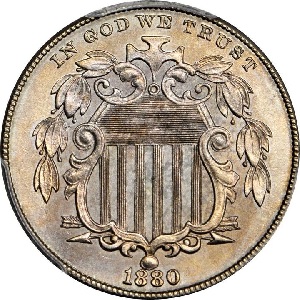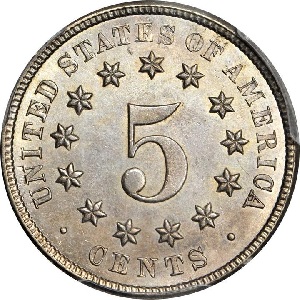1880 Shield Nickel
Millions of coins were hidden away during the Civil War and Reconstruction era. By the mid-1870’s, many small-denomination coins found their way back into circulation. Combined with new releases from the Mint, eventually a point was reached when there were more coins than what was needed for commerce.(1)
In latter part of 1876, the Treasury Department ordered a suspension of five-cent nickel coinage, except for proof issues. The order remained in force until December 1881.(2)
However, a quick glance at the Redbook reveals there were small mintages of business strike Shield nickels in 1879 and 1880.(3) How did this happen?
Philadelphia Mint superintendent Archibald L. Snowden requested and received special permission from the Mint Bureau and Treasury to strike a limited number of circulation pieces (i.e., non-proof) for the benefit of lower income collectors or anyone else desiring less expensive examples of freshly minted coins.(4)
This also explains the similarly low mintage circulation strike three-cent pieces, dimes, quarters, and half dollars of 1880.
Under this protocol, only 16,000 circulation Shield nickels were produced in 1880. Apparently, not many were retained as keepsakes, because only 100 examples are estimated to exist presently.(5)
It is a different story for 1880 Proof nickels, because there are plenty of them to go around for modern day collectors, readily available and at affordable prices. PCGS believes there are approximately 2700 nickels extant in the proof format.(6)
Because proof and business strike issues of the 1880 were struck from the same dies, it is sometimes difficult to distinguish which group a given example belongs to. There is a big difference in value, so it is especially important for collectors seeking the much more valuable circulation strike to purchase only those certified by a reputable third-party grading service.(7)
How ironic it is that Proof nickels of 1880 initially had a bigger price tag than their ordinary circulation counterparts from the same year. Their value relationship completely reversed decades ago and has carried forward to the current marketplace.
In the Rare Coins 101 survey of United States coinage, the 1880 Shield nickel scored among the very highest in terms of price percentage gains. That’s what happens when a true rarity becomes a collector’s longtime favorite.
| Estimated survivors in all grades: 100 ?
The survivor estimate from PCGS represents an average of one or more experts' opinions as to how many examples survive of a particular coin in all grades. Survival estimates include coins that are raw, certified by PCGS, and certified by other grading services. Learn more at PCGS. |
| PCGS Rarity Scale: 8.0 ?
The 'PCGS CoinFacts Rarity Scale' assesses the relative rarity of all U.S. coins, based on estimated surviving examples. The scale runs from 1.0 to 10.0. The higher the number, the rarer the coin.
Learn more at PCGS. |
| Click HERE to check for availability on eBay** |
Preview of eBay selection (note -- the Proof version of the 1880 nickel is NOT on the Key Date List of recommendations):
 |
 |
| Trendline Avg = 44.30 | BEST |
Historic Value Trend Charts:
| Last updated 2-5-25 | Return to Key Date Coin List | |
| Compare to Common Date Coin of Same Type | ||
|
|
||
| Download Charts to Your Computer | ||
Sources
1. Heritage Auctions. 1880 5C. Jul 2011 Auction.
2. Peters, Gloria and Mohon, Peters. Complete Guide to Shield and Liberty Head Nickels. Virginia Beach, VA: 1995.
3. Yeoman, R.S. and Garrett, Jeff, et al. A Guide Book of United States Coins, 75th ed. Pelham, AL: Whitman Publishing, 2021.
4. Stack's Bowers Galleries. 1880 Shield Nickel. Aug 2018 Auction.
5. PCGS. 1880 5C (Regular Strike).
6. PCGS. 1880 5C (Proof).
7. Heritage Auctions. 1880 5C. Aug 2014 Auction.
**Many very fine coin dealers sell on eBay. At any point in time, there may be over one million search results for United States coins. This includes quite a few of the recommendations on our Key Date Coin List.
If you’re thinking about purchasing a rare coin, eBay is certainly worth a look. For your convenience, the links from this site to eBay are coded to bring up only coins certified by PCGS and NGC.
As is always, always the case, never buy a valuable coin from a seller whose trustworthiness cannot be verified. Learn more about this at our chapter Best Places to Buy Coins, which also has a section on doing business on eBay.
In the interest of full disclosure, Rare Coins 101 receives a small commission anytime someone connects to eBay from this site and purchases something.
Coin images by Stack's Bowers Galleries.


